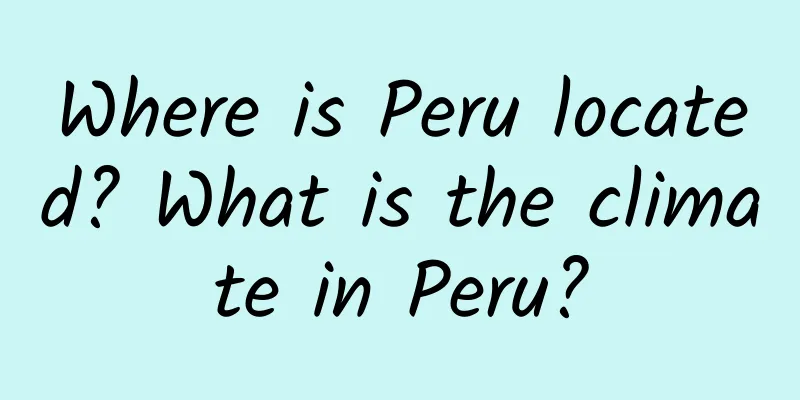Where is Peru located? What is the climate in Peru?

|
Peru is a country in western South America, bordering Ecuador and Colombia to the north, Brazil and Bolivia to the east, Chile to the south, and the Pacific Ocean to the west. Peru is one of the ancient civilization centers of Indians in the American continent. It once gave birth to the world-famous Norte civilization, Moche culture and Inca civilization. Let's open the following article to learn more about it! I hope it will be useful to you. Contents of this article 1. Where is Peru located? 2. What is the climate in Peru? 3. What impact does the Peruvian cold current have on coastal climate? 4. What is the geographical environment of Peru? 1Where is Peru located?The Republic of Peru, or Peru for short, is a country in western South America, bordering Ecuador and Colombia to the north, Brazil and Bolivia to the east, Chile to the south, and the Pacific Ocean to the west. Peru is one of the ancient centers of Indian civilization in the American continent. It once gave birth to the world-famous Norte Civilization, Moche Culture and Inca Civilization, the latter of which became the Inca Empire, the largest country in South America in the pre-Columbian period. Today, Peru is a presidential parliamentary democratic republic divided into 25 regions. The Andes Mountains run through the country from north to south, the western coastal areas are arid plains, and the east has the tropical rainforest of the Amazon Basin. Peru's economy mainly relies on agriculture, fisheries, mining and manufacturing (such as textiles). Peru has a population of 31.49 million, ranking fifth in South America. The official language is Spanish, and Quechua, Aymara and more than 30 other Indian languages are commonly used in some areas. 96% of the residents are Catholics. The fusion of cultural traditions of various ethnic groups has created a variety of expressions in the fields of art, food, literature and music. On January 1, 2018, Peru officially became a non-permanent member of the UN Security Council. 2What is the climate in Peru?Peru is a country in western South America, bordering Ecuador and Colombia to the north, Brazil and Bolivia to the east, Chile to the south, and the Pacific Ocean to the west. The whole country is divided into tropical desert, plateau and tropical rainforest climate from west to east. The western part of Peru has a tropical desert and grassland climate, which is dry and mild, with an average annual temperature of 12 to 32 degrees Celsius; the central part has a large temperature change, with an average annual temperature of 1 to 14 degrees Celsius; the eastern part has a tropical rainforest climate, with an average annual temperature of 24 to 35 degrees Celsius. The average temperature in the capital is 15 to 25 degrees Celsius. The annual precipitation is less than 50 mm in the west, 200 to 1,000 mm in the middle, and more than 2,000 mm in the east. 3What is the impact of the Peruvian cold current on coastal climate?The impact of cold currents on the climate is cooling and reducing humidity. Impact of the Peruvian cold current: 1. It makes the tropical desert climate on the west coast of South America even drier, forming the world's narrowest and longest tropical desert climate zone. 2. The distribution area of the tropical desert climate on the west coast of South America has expanded to lower latitudes and its range has been enlarged. Introduction to Peru Cold Current: Also known as the Humboldt Current, it is a compensatory current and the most powerful of the cold currents. It is a low-salinity ocean current that stretches from the southern tip of Chile to the northern Peru along the west coast of South America, flowing from the Antarctic to the equator. At the northern end, it can extend to 1,000 kilometers offshore, and its influence can even reach the Galapagos Islands. 4What is the geography of Peru?Peru is located in the western part of South America. It borders Ecuador and Colombia to the north, Brazil to the east, Chile to the south, Bolivia to the southeast, and the Pacific Ocean to the west. The coastline is 2,254 kilometers long. The Andes Mountains run from north to south. The whole territory is divided into three regions from west to east: the western coastal area is a narrow arid zone, a tropical desert area, with a dry and mild climate, intermittent plains, developed irrigation agriculture, and concentrated urban population. The central mountain plateau area is mainly the middle section of the Andes Mountains, with an average altitude of about 4,300 meters, and the source of the Amazon River. The eastern part is the Amazon tropical rainforest area, which belongs to the upper reaches of the Amazon River. It is a foothill area and alluvial plain, with high temperatures and heavy rains all year round, forests everywhere, and a vast land with few people. It is a newly developed oil production area in Peru. Huascarán Mountain is 6,768 meters above sea level and is the highest point in Peru. The main rivers are the Ucayali River and the Putumayo River. The whole country is divided into tropical desert, plateau and tropical rainforest climate from west to east. The western part of Peru has tropical desert and grassland climate, which is dry and mild, the central part has large temperature changes, and the eastern part has tropical rainforest climate. The time zone is West 5, which is 5 hours behind Greenwich Mean Time and 13 hours behind Beijing Time. Peru is rich in mining resources and is one of the 12 largest mining countries in the world. |
<<: Healthy Life Oil | What are the advantages of sesame oil and how to choose it?
>>: Is Peru a wealthy country? Why are there so many Chinese in Peru?
Recommend
What body type is the most difficult for women to get pregnant?
Some women find it difficult to conceive due to t...
Eating these foods for colds is more effective than taking medicine
Colds are common diseases that can occur in any s...
Normal early pregnancy secretion pictures
The appearance of brown secretions in early pregn...
Can I swim with a tampon during my period?
Internal tampons are also called sanitary tampons...
How to maintain after uterine fibroid surgery
Uterine fibroids are a relatively common gynecolo...
What to do if women have dysmenorrhea and endocrine disorders
There are always a few days every month that most...
What causes cervical cysts in women?
Cervical cysts are generally inflammatory. It is ...
Can pregnant women eat cherries in the early stage
Many women experience a loss of appetite and are ...
Why do I sweat between my breasts?
In many cases, people will experience chest sweat...
How to choose kidney beans? Can kidney beans help you lose weight?
In daily diet, eating fried kidney beans is not o...
Menstruation is always unclean
Because women have different physical conditions,...
How to do a postpartum pelvic examination?
If women choose to give birth naturally, then the...
How to prevent premenstrual acne
During menstruation, due to changes in the female...
How to stir-fry Chinese cabbage? Can Chinese cabbage be eaten after being blanched and frozen?
Chinese cabbage contains vitamin B1, vitamin B6, ...
Symptoms of early pregnancy after 10 days of amenorrhea
Many women experience early pregnancy 10 days aft...









